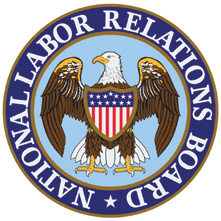By Russell W. Jackson
On September 9, 2019, the NLRB determined that a petitioned-for unit of two groups of Boeing employees was not an appropriate unit under the NLRA. The case is Boeing Company and International Association of Machinists and Aerospace Workers.
Factual Background
The two classifications involved technicians and quality inspectors at Boeing’s North Charleston, SC facility, where it manufactures 787 aircrafts. The facility has 2700 production and maintenance employees. The production of the airplane’s tail occurs in the AFT building. The body and wings are built in the Mid-Body Building. The tail, body and wings then travel to the Final Assembly Building where they are joined. In each of the three buildings, technicians perform the work, and quality inspectors check the work.
After Final Assembly, the airplane is taken to the Flight Line. At the Flight Line, the aircraft is powered for the first time, finalized, tested, certified and delivered to the customer. The technicians working at the Flight Line are Flight Line Readiness Technicians (“FRTs”). The quality inspectors at Flight Line are Flight Line Readiness Technician Inspectors (“FRTIs”).
After a failed attempt at unionizing the 2700 workers, the Union petitioned to represent a bargaining unit comprised of only the FRTs and FRTIs, approximately 178 employees. Boeing refused to bargain. In May 2018, the Regional Director concluded the petitioned-for unit was appropriate.
FRTs are in Boeing’s operations department with the other technicians at the facility. FRTIs belong to the quality department with the other quality inspectors. FRTs are supervised by nine operations managers, two of whom also supervise excluded employees. FRTIs are supervised by field quality managers, who also provide instruction to excluded inspectors.
FRTs and FRTIs earn higher wages than most other employees. Aside from a few minor distinctions, including the dress code and slightly different shifts, FRTs and FRTIs share all other terms and conditions with the excluded employees. These include: timekeeping system, payroll and direct deposit system, performance management system to determine pay and raises, attendance guidelines, overtime system, disciplinary program, policies for environmental health and safety, same hiring practices, leave policies, healthcare benefits and dental plan, investment plans, life insurance and disability plans, flexible spending accounts, gift matching programs, physical fitness program, cash awards program, badge protocols, and alternative dispute resolution program.
The Board’s Analysis
The Board clarified its 2017 decision in PCC Structurals, which had overturned the NLRB’s Specialty Healthcare decision. Specialty Healthcare had made it easier to unionize smaller groups of employees (i.e., micro-units), rather than the entire workforce. In PCC Structurals, the NLRB announced its return to the community of interest standard. The Board in PCC Structurals applied the traditional test to determine whether the petitioned-for-employees share a community of interest sufficiently distinct from employees excluded from the proposed unit to warrant a separate appropriate unit. In Boeing, the Board’s clarification of PCC Structurals set forth the following relevant three-step process:
- The proposed unit must share an internal community of interest.
- The interests of those within the proposed unit and the shared and distinct interests of those excluded from the proposed unit must be comparatively analyzed and weighed.
- Consideration must be given to the Board’s decisions on appropriate units in the particular industry.
Step One – Shared Interests in Petitioned-For Unit
The analysis begins with whether the petitioned-for unit has an internal community of interest. A unit without such an interest is inappropriate.
The Board held that the FRTs and FRTIs were too distinct to form a community of interest. The similarities of the employees included: nearly identical terms and conditions of employment, frequent daily contact with each other at the Flight Line, and sharing many of the same skills and training.
However, the Board found the groups had significantly different interests in the context of collective bargaining. They are in separate departments and have different supervisors. They have fundamentally different job functions – FRTs are technicians who perform the mechanical work; FRTIs are inspectors who check for quality. Based on these differences, the Board held the two groups did not share a community of interest.
Step Two – Shared Interests Between Petitioned-For Unit and Excluded Employees
The second step requires an analysis of the included and excluded employees. At this stage, the Board determines whether excluded employees have meaningfully distinct interests in the context of collective bargaining that outweigh similarities with unit members. If the distinct interests do not outweigh the similarities, the micro-unit is inappropriate.
The Board determined the interests of excluded employees were not meaningfully distinct from and did not outweigh similarities with the interests of the petitioned-for employees. The Board found noteworthy that all 2700 employees work towards producing a single product – the 787 aircraft. The FRTs and FRTIs are only responsible for about one percent of the entire process’s tasks.
Fourteen percent of FRTs’ and FRTIs’ functions overlap with work also performed by excluded employees. A portion of the work exclusive to the Flight Line is at least similar, if not redundant of, work performed by excluded employees. The Board found the factors that distinguish FRTs and FRTIs from the excluded employees were relatively insignificant for purposes of collective bargaining. Although FRTs and FRTIs have higher wages than many excluded employees, they share almost all other terms and conditions of employment with excluded employees, including all personnel policies and benefits.
Aside from one certification required for employees working on the aircraft in repair station status, FRTs and other technicians possess almost identical skills and training, while FRTIs share the same with the other excluded inspectors. The Board found noteworthy that repair station status – which requires a particular license for FRTs and FRTIs – lasts only a small portion of time the aircraft is on the Flight Line. The Board determined it was unlikely that the unit’s interests related to skills and training are much different than the interests of the excluded employees.
Contact was the only factor weighing in favor of the petitioned-for unit. FRTs and FRTIs generally only have contact with a small number of other employees who come to Flight Line to provide assistance. This, however, was not enough of a difference to establish a separate micro-unit.
FRTs and FRTIs are fully functionally integrated with excluded employees, share departments with excluded employees, share supervision with excluded employees, perform the same job functions as excluded employees, share terms and conditions with excluded employees, and share the same skills and training with excluded employees. As a result, the Board found that the excluded employees have the same collective bargaining interests as FRTs and FRTIs.
Step Three – Special Considerations for Industry, Facility or Employer
At the final stage, the Board determines whether special considerations exist in the industry. The Board determined that no considerations exist in this situation. The Board rejected Boeing’s contention that there is a presumption favoring a plantwide unit, which must be rebutted be a union seeking a smaller unit.
Board’s Conclusion
The Board found the petitioned-for unit employees do not share an internal community of interest and their interests were not sufficiently distinct from those of excluded employees. As a result, the Board vacated the Union’s certification.
Dissent
Member McFerran was the lone dissent. She contended that under the majority’s view, the only appropriate unit is one that combines all 2700 production and maintenance employees at the facility. McFerran criticized the Board’s implementation of the three-step process, and, in particular, the second step – identifying differences between the petitioned-for unit and the excluded employees. She described the weighing of excluded employees’ interests as “an upending of well-settled unit determination principles that PCC Structurals purported to reinstate.” McFerran argued that even applying the three-step process, there was no basis for determining the petitioned-for unit as inappropriate. McFerran found that a community-of-interest did exist because the FRTs and FRTIs are highly skilled individuals who possess a license which only six percent of other workers possess; they perform distinct job functions of rendering operational and then testing the fully operational aircraft; they have no meaningful contact with other employees; they have limited interchange with other employees; they are separately supervised and attend daily separate supervisory meetings with each other; higher wages; they also have unique shift and hours, mandatory drug testing program and special safety procedures.
Conclusion
Based on the Boeing decision, employers should have stronger arguments to combat union’s attempts at organizing micro-units. However, employers should be aware that unions will continue to attempt to unionize smaller groups of employees and be ready to oppose such measures if the above-referenced three step factors weigh against such a proposed unit.

FordHarrison
rjackson@fordharrison.com
www.fordharrison.com
